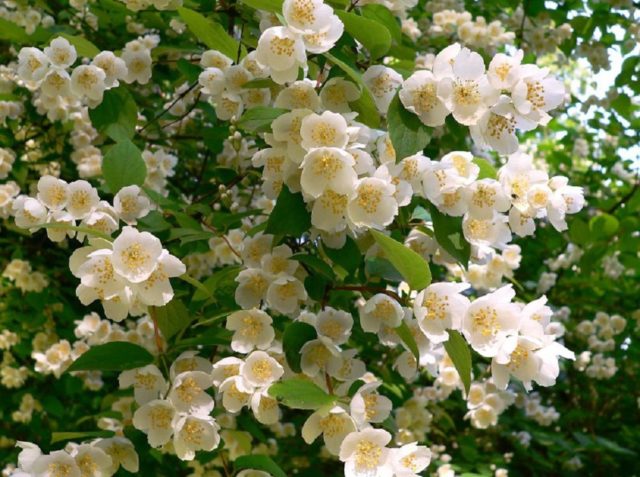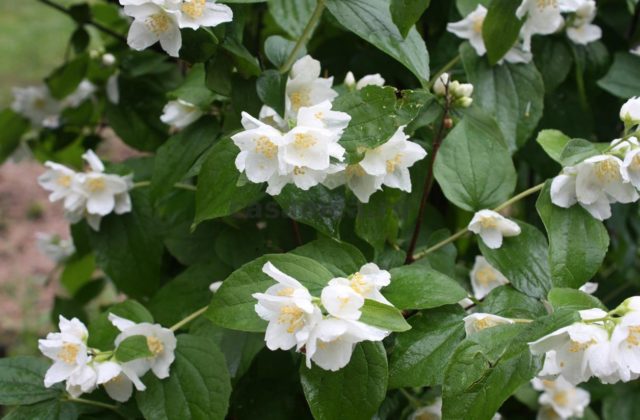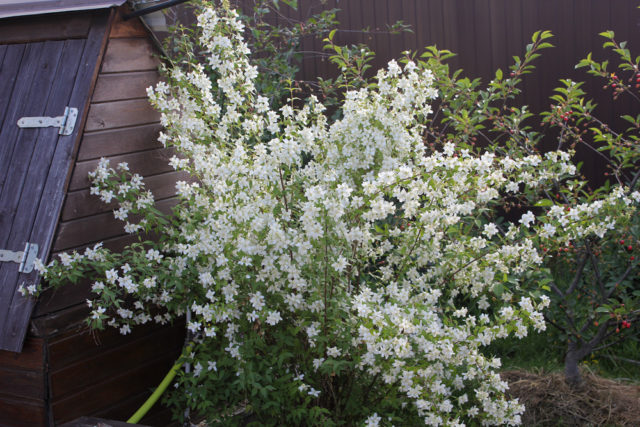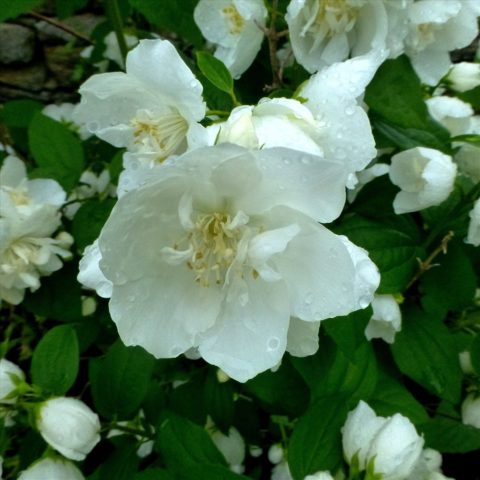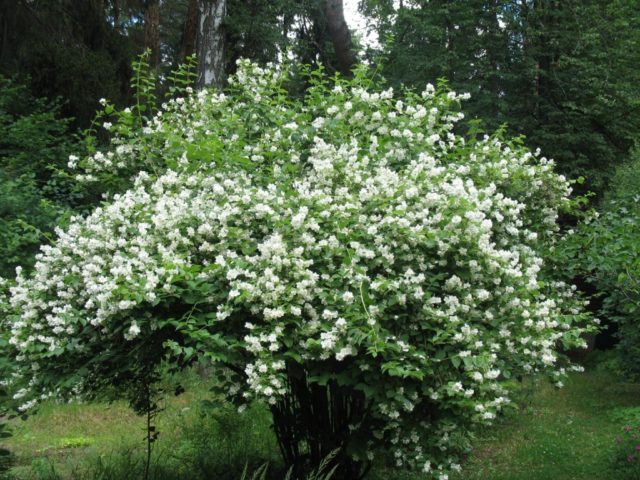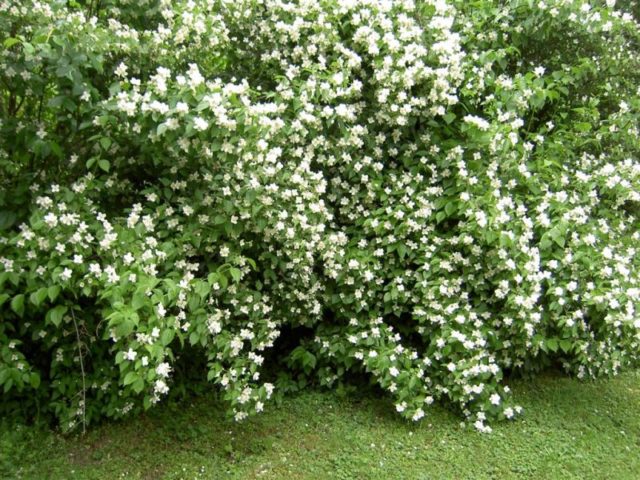Content
Chubushnik has been blooming for 50 years, if you properly care for it. It is important to start taking care of the shrub as early as July, when the previous flowering is over. Garden jasmine was brought to Russia from Western Europe. Due to the large number of light, white or creamy inflorescences, the mock-orange has long been considered a symbol of an ornamental garden. The scent fills the entire space around the shrub and even spreads a few meters around.
When garden jasmine blooms
In Central Russia, flowers appear in June and July. Early varieties bloom in May. If you choose the species according to the flowering time, then you can achieve a continuous fragrance of garden jasmine for two months.
On what shoots does mock-orange bloom?
Garden jasmine plants flower buds on the shoots of the current year. To do this, immediately after the end of flowering, branches with dried inflorescences are removed. Thus, they direct the forces of the chubushnik to strengthen last year's shoots and further growth. On uncut bushes, many branched growths with a small number of small flowers soon appear.
What year after planting does the chubushnik bloom?
The shrub is prized for its fast growth, beauty and early flowering. Chubushnik blooms in the third year after planting. Under the weight of fragrant inflorescences, the branches bend to the ground. The heady scent of garden jasmine has a positive effect on the emotional state.
Blossoming timing depending on the variety and region of cultivation
Garden jasmine is a frost-resistant shrub. The flowering period of the shrub is different in accordance with certain climatic conditions and varietal varieties.
- Crown mock or ordinary blooms for 30 days. Plant height 3.5 m. The process of bud formation begins in the second decade of May.
- Blooms in early June small-leaved chubushnik - shrub up to 1 m high. The buds smell of strawberries.
- A little earlier, the chubushnik thin-leaved variety begins to bloom Shrenk. The type differs in a long period of fragrance.
- Variety Shneeshturm begins to bloom from the end of June. The process lasts 2 months.
- Virgin garden jasmine differs in beautiful double inflorescences. Blooms in July and is capable of fragrant for a whole month.
- Variety Gordon able to bloom again in autumn.
How many chubushnik blooms
In general, the flowering time of the chubushnik falls on May and lasts until September. Inflorescences are cream-colored, have five petals. The ornamental shrub takes an average of 2-5 weeks to smell, in a shady place much longer. Some summer varieties can bloom again in the fall.
Several reasons why chubushnik does not bloom
There are few reasons why garden jasmine has no buds. And before taking actions to restore flowering, you need to understand them in detail. After all, the shrub is unpretentious in care and calmly tolerates external negative factors.
Poor quality planting material
A healthy seedling is the key to full development and future flowering.It is advisable to buy planting material in specialized stores, and not in spontaneous markets. The seller should consult about the varieties that are suitable for a specific planting region.
The young plant should be free of visible spots, traces of diseases, dry shoots and yellow foliage. Typically, containerized seedlings are commercially available. The soil in such a container must be clean and free of mold. Otherwise, the garden culture may be damaged by infectious diseases.
Violation of landing rules
Another reason for refusing to bloom is the wrong landing site. If the chubushnik is in the shade, then it should be transferred to a sunny area. The shrub is light-loving, with a lack of lighting, the shoots are pulled out, and the buds are not formed.
The lack of flowering of the chubushnik can occur due to an illiterately performed planting. With excessive deepening of the seedling, the root collar undergoes it. The plant does not fully develop.
For garden jasmine, the composition of the soil matters. The land in which the bush is planted must be fertilized. If this moment is missed, it is recommended to transplant the chubushnik into a fertile soil layer. Preference is given to moist, loose soil.
Violation of the rules of cultivation
In areas where the soil does not completely dry out, there is no place for a mock-orange. Or take care of drainage. A layer of gravel, pebbles, rubble 10-15 cm thick saves the situation. Lack of moisture will provoke wilting of leaves, loss of turgor. Without water, the mock-orange will not bloom, it will simply dry out.
Lack of nutrients in the soil negatively affects the flowering of the mock-orange. After three years, the shrub needs full nutrition with mineral fertilizers. It responds well to organic fertilizers in early summer.
Another reason why the mock-orange does not bloom is poor wintering. If the winter was harsh and the plant was not covered, the annual shoots would freeze.
Pests and diseases are another reason why the common mock-orange does not bloom
It is often found that garden jasmine does not come to the budding stage. This happens due to attacks of harmful insects: aphids, weevils, spider mites. Fortunately, you can get rid of them with insecticides. Processing is carried out in the autumn and spring seasons. For the chubushnik it is recommended to use the drug "Karbofos". Apply the chemical according to the instructions.
In addition to insects, fungal diseases affect the condition of the shrub: gray rot, septoria spot. Systemic fungicides will help eliminate negative symptoms.
How to make a chubushnik bloom
In order for garden jasmine to please with its flowering, you must follow the basic rules for planting and care. The plant needs regular watering, timely weeding of the soil around the bush, and loosening of the soil. It is advisable to plant shrubs in sunny areas with possible shading, where there is no constant stagnation of moisture.
Basic conditions for lush flowering.
- Fertilizer. Fertilizing with mineral fertilizers is carried out twice during the growing season. The first time is in the spring with the beginning of growth or at the time of full blooming of the leaves. Presumably it is March-April. The second time is in the fall, from the last week of August to October. At the beginning of intensive shrub growth, it is preferable to use nitrogen-containing preparations. During the inception and opening of flower buds, it is better to apply potash fertilizers. Phosphorus compounds are added throughout the summer. Liquid dressings are considered the most effective.
- Pruning. At the end of June, you should prune your garden jasmine. Remove thickened shoots that grow inside the shrub. In place, it is necessary to leave young shoots so that the mock-orange blooms in the new season. Next year, in the spring, around March, it is worth thinning the bush. Provided that it has grown a lot.Do not forget about the rejuvenation of the bush. Branches that are 10 or more years old should be removed at the root. By trimming the crown, a powerful stimulation of flowering and growth of the mock-orange will occur.
- Most types of chubushnik differ frost resistance. Even if the shoots freeze, they quickly recover. Shelter for the winter is not required. However, you need to take care of the root system before winter. The soil under the bushes is mulched with peat or pine needles with a layer thickness of 3-4 cm.
- At the moment of swelling of the kidneys, before and after the flowering period of the chubushnik, it is recommended to carry out preventive spraying with insecticides and fungicides.
- If necessary, transplants perform the procedure in early autumn or spring. First you need to water the shrub abundantly with water and let it stand for a day. The transplant is carried out in the evening, after cutting off part of the dry shoots.
Conclusion
Chubushnik blooms if comfortable conditions are created. The shrub does not need shelter for the winter, however, proper pruning of shoots, regular feeding and watering are required. Equally important is the choice of planting site and variety. If you follow all the recommendations for leaving, the mock-orange will definitely bloom brightly and for a long time.
